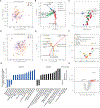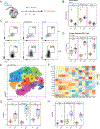Clinical and molecular features of acquired resistance to immunotherapy in non-small cell lung cancer
- PMID: 38215748
- PMCID: PMC11249385
- DOI: 10.1016/j.ccell.2023.12.013
Clinical and molecular features of acquired resistance to immunotherapy in non-small cell lung cancer
Abstract
Although immunotherapy with PD-(L)1 blockade is routine for lung cancer, little is known about acquired resistance. Among 1,201 patients with non-small cell lung cancer (NSCLC) treated with PD-(L)1 blockade, acquired resistance is common, occurring in >60% of initial responders. Acquired resistance shows differential expression of inflammation and interferon (IFN) signaling. Relapsed tumors can be separated by upregulated or stable expression of IFNγ response genes. Upregulation of IFNγ response genes is associated with putative routes of resistance characterized by signatures of persistent IFN signaling, immune dysfunction, and mutations in antigen presentation genes which can be recapitulated in multiple murine models of acquired resistance to PD-(L)1 blockade after in vitro IFNγ treatment. Acquired resistance to PD-(L)1 blockade in NSCLC is associated with an ongoing, but altered IFN response. The persistently inflamed, rather than excluded or deserted, tumor microenvironment of acquired resistance may inform therapeutic strategies to effectively reprogram and reverse acquired resistance.
Keywords: Clonal selection; Genomics and Transcriptomics; Immune escape; Immune-checkpoint blockade; Interferon alpha/gamma response; Neoantigens; T cell exhaustion; Tumor heterogeneity; Type I and Type II Interferons; anti-PD-1 therapy.
Copyright © 2023 The Authors. Published by Elsevier Inc. All rights reserved.
Conflict of interest statement
Declaration of interests A.J.S. reports consulting/advising role to J&J, KSQ therapeutics, BMS, Merck, Enara Bio, Perceptive Advisors, Oppenheimer and Co, Umoja Biopharma, Legend Biotech, Iovance Biotherapeutics, Prelude Therapeutics, Immunocore, Lyell Immunopharma, Amgen and Heat Biologics. Research funding: GSK (Inst), PACT pharma (Inst), Iovance Biotherapeutics (Inst), Achilles therapeutics (Inst), Merck (Inst), BMS (Inst), Harpoon Therapeutics (Inst) and Amgen (Inst). MDH reports research grant from BMS; personal fees from Achilles; Arcus; AstraZeneca; Blueprint; BMS; Genentech/Roche; Genzyme/Sanofi, Immunai; Instil Bio; Janssen; Merck; Mirati; Natera; Nektar; Pact Pharma; Regeneron; Shattuck Labs; Syndax; as well as equity options from Arcus, Factorial, Immunai, and Shattuck Labs. A patent filed by Memorial Sloan Kettering related to the use of tumor mutational burden to predict response to immunotherapy (PCT/US2015/062208) is pending and licensed by PGDx. J.L. has received honoraria from Targeted Oncology and Physicians’ Education Resource. D.M. is an employee of M:M Bio Limited. D.M. reports consulting role to Shattuck Labs and Corbus Pharma. T.M. is a consultant for Daiichi Sankyo Co, Leap Therapeutics, Immunos Therapeutics, and Pfizer, and co-founder of Imvaq Therapeutics. T.M. has equity in Imvaq therapeutics. T.M. reports grants from Bristol Myers Squibb, Surface Oncology, Kyn Therapeutics, Infinity Pharmaceuticals, Peregrine Pharmaceuticals, Adaptive Biotechnologies, Leap Therapeutics, and Aprea. T.M. is an inventor on patent applications related to work on oncolytic viral therapy, alphavirus-based vaccines, neo-antigen modeling, CD40, GITR, OX40, PD-1, and CTLA-4. B.D.G. has received honoraria for speaking engagements from Merck, Bristol Meyers Squibb, and Chugai Pharmaceuticals; has received research funding from Bristol Meyers Squibb and Merck; and has been a compensated consultant for Darwin Health, Merck, PMV Pharma, Shennon Biotechnologies, and Rome Therapeutics of which he is a co-founder. B.D.G. is part of a patent related to neoantigen prediction (WO2018136664A1, PCT/US2023/011643). G.F. and T.H.S. are employees and stockholders of Shattuck Labs, Inc. M.L.M. has received honorarium from GSK. H.R., X.Z., M.R.K., I.A., R.S., J.C.B., M.L.M., and M.D.H. are current employees and stockholders of AstraZeneca.
Figures







References
-
- Anagnostou V, Smith KN, Forde PM, Niknafs N, Bhattacharya R, White J, Zhang T, Adleff V, Phallen J, Wali N, et al. (2017). Evolution of Neoantigen Landscape during Immune Checkpoint Blockade in Non-Small Cell Lung Cancer. Cancer Discov. 7, 264–276. 10.1158/2159-8290.CD-16-0828. - DOI - PMC - PubMed
Publication types
MeSH terms
Substances
Grants and funding
LinkOut - more resources
Full Text Sources
Medical
Molecular Biology Databases
Research Materials

